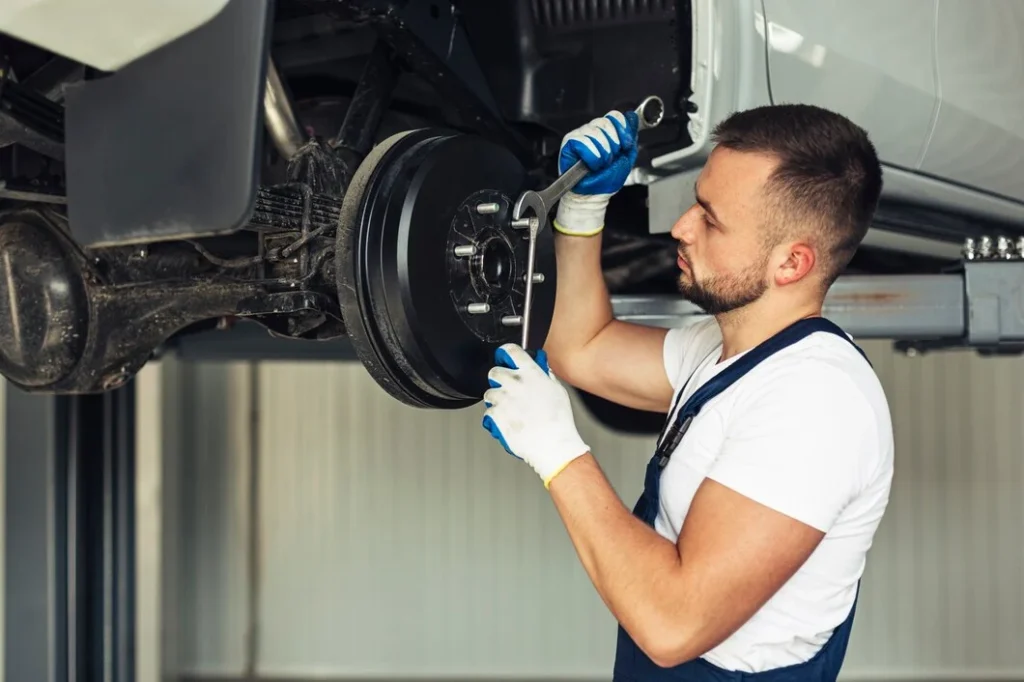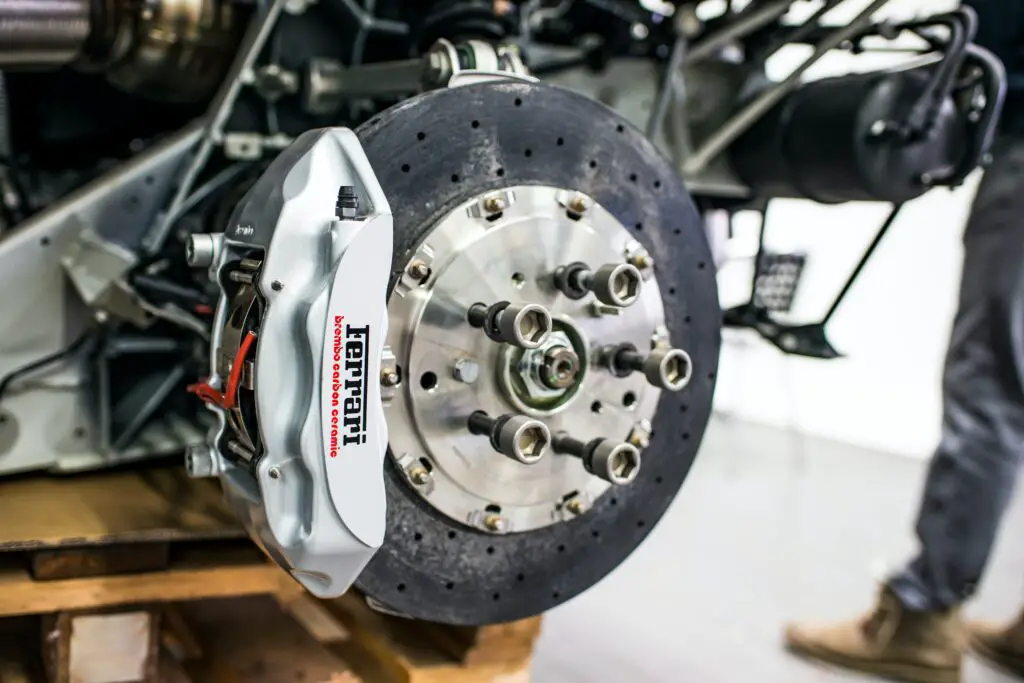Experiencing Soft Spongy brakes after bleeding the brake lines is frustrating. You went through the proper bleeding procedure to eliminate trapped air, so why do the brakes still lack firmness and braking power?
This common problem is usually caused by continued air entry or fluid contamination in the hydraulic system. We’ll explore the root causes, plus proven solutions to restore solid brake pedal feel after bleeding.
What Causes Spongy Brakes After Bleeding?
If your brake pedal still feels soft and sinks to the floor after bleeding the lines, one of these culprits is likely the cause:
1. Improper Bleeding Method
Bleeding brakes take some finesse and follow the proper sequence. If air pockets still exist after bleeding, the method needs revisiting. Mastering the vacuum or pressure bleeding process takes practice.
2. Undetected System Leak
Even the smallest leak in a caliper seal, brake line, or hose can introduce air back into the hydraulic lines after bleeding. Tracking down that last elusive leak can be challenging.
3. Contaminated Brake Fluid
Old fluid with high moisture content and copper corrosion continues causing issues even after bleeding. Contaminants damage valves and seals, allowing air ingress.
4. Faulty Brake Components
Age and wear take their toll on master cylinders, ABS modulators, and wheel cylinders. Damaged seals and valves enable air to keep entering, diminishing brake power no matter how often you bleed.
Step-by-step fixes for Spongy Brakes After Bleeding
Now that you know why brakes stay spongy after bleeding, here are tips for restoring that firm brake pedal:
1. Verify Proper Brake Bleeding Method
Bleeding out all trapped air takes the right process. Revisit your brake bleeding method to check for possible errors:
Incorrect sequence – Start farthest from the master cylinder, working towards the closest. The typical order is right rear, left rear, right front, left front.
Early valve closure – Don’t close bleeder valves until the stream flows bubble-free. This avoids trapping air still in the line.
Too little pedal pumping – Gentle, full-range pumping can help dislodge stubborn bubbles during bleeding. Don’t overdo it on older master cylinders though.
No clear hose – Seeing bubbles flow through a transparent bleeder hose confirms when all air evacuates vs guessing based on pedal feel alone.
Taking your time and double-checking for air with clear tubes can eliminate the unfinished bleeding oversight.
2. Pressurize System to Detect Leaks
Pinpointing that last little brake fluid leak allowing compressed air to sneak back in can be frustrating. Here’s an easier method to discover the culprit:
Use a brake bleeder syringe to inject pressurized fluid into the system. Spray brake cleaner around lines, fittings, and seals while watching for escaping bubbles. The leak source will continuously form tiny air bubbles exiting the hole.
Once identified, seal the leaking bleed nipple, line, caliper, or cylinder. Then bleed the system again to purge any entered air.
3. Flush with Fresh Fluid
Moisture-contaminated old brake fluid is hygroscopic – it attracts more moisture from the air over time. The water content eventually corrodes components and valves internally.
Flushing the entire system with new fluid eliminates these contaminants. Use the vacuum or pressure bleeding method to thoroughly replace at least 2-3 full reservoirs worth of fluid.
Follow up by bleeding to remove any final traces of moisture or debris to experience a firm brake response again. Consider switching to a higher-temperature DOT 5.1 synthetic formula as added protection.
4. Replace Worn Components
Spongy Brakes After Bleeding. On high-mileage vehicles, deteriorated rubber seals inside master cylinders, wheel cylinders, caliper pistons, and ABS valves permit air intrusion no matter how well you bleed. Intermittent failure of these parts is the hardest spongy pedal cause to diagnose.
Closely inspect all aging brake system components for leakage, sticking, and performance degradation indicating replacement needs. Baked-on brake fluid and bulging rubber seals signify internal wear. Restore like-new braking by overhauling any questionable parts in addition to bleeding.
Why Won’t Brakes Firm Up After Bleeding?
If you recently replaced any brake hardware like lines, calipers or a master cylinder, improper assembly rather than worn parts could be preventing a hard pedal after bleeding:

Loose bleeder fitting – Double check for snug bleeder valve installation not allowing air sucked back in.
Pinned caliper piston – Binding piston movement won’t retract the pads after releasing the pedal to apply consistent clamping force.
Insufficient fluid level – Keep the reservoir topped off as bleeding progresses. Running too low introduces air at the last minute.
Too much pedal travel – Brake bias affects the “sweet spot” for best pedal pressure before engaging ABS. Adjust to around 30% of full travel for ideal firmness.
Is Driving with Spongy Brakes Dangerous?
Spongy brake pedals indicate an air gap still lingering somewhere in the hydraulic system. Air is compressible while brake fluid is not. This cushioning effect results in a mushy pedal with extended downward travel before braking action finally occurs.
The danger is the major delay in developing significant stopping power. With compromised brakes, the car travels a longer distance before slowing down enough for control. This also forces heavier pedal pressure closer to the floor to achieve the same G-forces for slowing when ABS should take over on slippery roads.
Avoid driving the vehicle if possible until brake system firmness is restored. Get the underlying cause fixed to transform those soft brakes back into a responsive, trustworthy emergency stopping power again. Prioritize driving safety – identify and repair the true problem rather than simply repeating short-term brake bleeding alone.
Common Causes of Lingering Spongy Brakes
Do you think you’re searching for the real root cause of lingering brake softness post-bleeding? Here are the most overlooked culprits:
Failing Master Cylinder
The master cylinder acts as the pump sending pressurized brake fluid through the lines. Internal seal wear and valve sticking prevent building proper hydraulic pressure no matter how thoroughly you bleed the system downstream. Replace the cylinder to resolve those lingering spongy brakes for good.
Blocked Brake Line
Corrosion debris, a lodged pebble near a wheel hub, and sticky piston seal material can obstruct fluid return flow causing uneven brake clamping. Soft pedals result from routes bottlenecked by various stuck particles. Flushing debris and contamination restores unrestricted flow and brake firmness.
Bad Brake Booster
The brake booster multiplies muscle power applied to the brake pedal before sending hydraulic pressure onward through the system. When this vacuum-based amplifier fails from a torn diaphragm, linkage issue, or valve blockage, pedal pressure never reaches full braking potential no matter how far the pedal travels.
Seized Brake Caliper Piston
Spongy Brakes After Bleeding. Corrosion from the worn piston and caliper seals prevents the piston from retracting fully once brake pressure is released at the pedal. Always partially clamping the pads causes brake drag, friction heat, and a stubborn spongy pedal after bleeding which refuses to firm up.
As you can see, worn rubber seals and sticking hydraulic valves are common threads running through the root causes of soft brake pedals even after bleeding fully. Identify and then fix the problem component rather than repeatedly bleeding without lasting success.

How Can I Firm Up My Brake Pedal?
If you feel Soft and Spongy brakes after bleeding the system multiple times, try these troubleshooting steps:
Adjust the rear drum brakes – Out-of-adjustment rear shoes prevent enough hydraulic pressure from reaching the front disc brakes. Turn the adjusting starwheel to retract the shoes closer to the drum.
Lubricate brake linkage – Stuck pivots and corroded master cylinder pushrod linkage reduce pedal leverage force. Clean and lube all contact points.
Check brake light switch – Malfunctioning electrical contacts affect how far you can depress the pedal. Adjust or replace the brake light activation switch.
Upgrade brake pads – Premium pads grip better with less pedal travel to achieve the same G-force. Consistent friction material deposits ensure a reliable grip.
Flush old brake fluid – Moisture-contaminated fluid moisture corrodes the master cylinder and the ABS valve seals and allows air intrusion.
Spongy Brakes After Bleeding. If improperly bleeding the brakes alone cannot firm up a mushy pedal, focus on pinpointing the sticking mechanical components or fluid contamination responsible for fixing the root problem permanently.
FAQs – Spongy Brakes After Bleeding
Why is my brake pedal still spongy after bleeding?
The most likely causes are a remaining leak in the system allowing additional air entry, contaminated old brake fluid still causing issues, or a worn component like a master cylinder or ABS valve that needs replacement.
Why won’t my brakes build pressure after bleeding?
Causes include leaks allowing continued air ingress, stuck pistons unable to retract and apply consistent clamping force, an insufficient fluid level not keeping the system full, and incorrect brake pedal free play range.
Why are my brakes going to the floor after bleeding?
Brakes that sink to the floor even after bleeding indicate a serious system issue like a brake fluid leak or failure in a master cylinder, typically caused by a blown piston seal. This allows air to compress instead of hydraulic pressure transferring to the brake pads & rotors.
Will spongy brakes fix themselves?
No – the underlying cause of air gaps, leaks, contamination, or component wear will not self-resolve over time. I am ignoring the problem risks of brake failure and escalating repair costs. The spongy pedal symptom needs prompt troubleshooting and repair.
How do I fix spongy brakes?
Check for leaks allowing air ingress, flush contaminated brake fluid with fresh fluid, bleed using the vacuum method to fully evacuate air pockets, and replace any overly worn parts like deteriorated rubber seals and sticking hydraulic pistons.
Conclusion
Spongy brake pedals after bleeding are frustrating and dangerous. With compromised braking power, vehicles require more stopping distance. Identifying the true underlying cause of air gaps in the hydraulic system is key to restoring solid brake pedal feel and function. Often the issue comes down to worn parts, stubborn trapped air pockets, or moisture-contaminated fluid rather than bleeding mistakes. Take time to pressure test and clean or replace contaminated and damaged components. Soon you’ll enjoy the consistent braking power of a firm brake pedal once again Hope you understand the reason for spongy brakes after bleeding and how to fix it.

